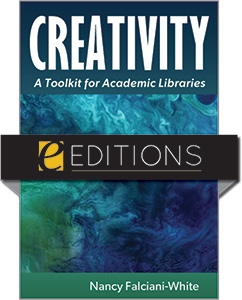
Primary tabs
You don't need to be an ALA Member to purchase from the ALA Store, but you'll be asked to create an online account/profile during checkout to proceed. This Web Account is for both Members and non-Members. Note that your ALA Member discount will be applied at the final step of the checkout process.
If you are Tax-Exempt, please verify that your account is currently set up as exempt before placing your order, as our new fulfillment center will need current documentation. Learn how to verify here.
- Description
- Table of Contents
- About the author
Use creativity to create change in your library!
Creativity is the ability to produce a product or idea that is both new and appropriate in a given context, and is essential for innovation, change, and employee satisfaction. Creativity is inherently human, a transferable skill that can be developed and that can improve an individual’s personal and professional life regardless of their level of artistic ability, education, or experience.
Academic libraries are often the first to face budget reductions, hiring freezes, and staff reductions when higher education encounters financial stress, and creativity can seem like either a luxury or an attempt to spur libraries to support the needs of their institution without adequate staff and funding. However, creativity is vital at all levels of the academic library if that library expects to adapt to the current challenges facing higher education. Change is necessary for adaptation, and creativity is essential for change.
Creativity: A Toolkit for Academic Libraries can help you create, encourage, and participate in an environment that is conducive to creativity, helping make change a more natural and organic part of the library’s culture. The first part, Understanding Creativity, looks at the psychology of creativity and its use in design thinking, innovation, research, and physical and social environments. The second, Creativity in Context, examines perspectives of library staff and creativity in academic library literature, and how to enhance personal creativity and foster it in your library.
Greater creativity in librarianship—and creating a culture that values trial and error along with successes—needs to be encouraged by those in library leadership, in the library profession more broadly, and in institutions of higher education. Creativity: A Toolkit for Academic Libraries can be the first step in developing your own creativity and advocating for it across your institution.
Introduction
Notes
Bibliography
Part 1. Understanding Creativity
Chapter 1. The Psychology of Creativity
The Genius and the Muse
Creativity in Modern Psychology
The Creative Person
The Creative Process
The Creative Press
The Creative Product
Measuring Creativity
Common Creativity Myths
Creativity Exists Only in the Fine Arts
All Creative People Share Specific Creative Traits
Creativity Is a Linear Process
Creativity Is Inherent and Cannot Be Taught
Creativity Is Associated with Mental Illness
Creativity Is Correlated with Intelligence
Circumstances Do Not Impact Creativity
Experience Does Not Impact Creativity
Creativity Cannot Be Measured
Current Trends and Future Research
Notes
Bibliography
Chapter 2. Creativity, Innovation, Design Thinking, and More
Introduction
Invention
Innovation
Entrepreneurship
Creative Problem Solving
Design Thinking
The Role of Creativity
Notes
Bibliography
Chapter 3. Physical and Social Environments
Impact of the Physical Environment on Creativity
Impact of the Social Environment on Creativity
The Physical Library
Notes
Bibliography
Chapter 4. The Creativity of Research
Research Models
Creativity Models
Creativity and Research
Creativity, Research, and Libraries
Notes
Bibliography
Part 2. Creativity in Context
Chapter 5. Perspectives of Academic Library Staff
Demographics
Creativity in the Workplace
Defining Creativity
Types of Creative Work
Sources of Creative Inspiration
Expectations of Creativity
Preparation and Development of Creativity
Barriers to Creativity
What Supports Creativity
Role of Creativity in Professional Work
Notes
Bibliography
Chapter 6. Creativity in Academic Library Literature
Outreach and Marketing
Instruction
Other Public Services
Collection Development
Technical Services
Leadership
Other Areas
Notes
Bibliography
Chapter 7. Enhancing Personal Creativity
Developing Personal Creativity
Be Intentional
Develop Basic Skills
Continue to Learn within the Profession
Practice Curiosity and Exploration
Develop Tolerance for Risk-Taking
Develop Self-Management Skills
Practice Divergent Thinking
Find Problems, Solve Problems
Communication
Summary
Notes
Bibliography
Chapter 8. Fostering Creativity
Value of Creativity
Role of Leaders in Developing Creativity
Leadership Theories
Fostering Creativity in an Organization
Ensure Psychological Safety
Personalize Physical Environment
Model Intentional Communication
Encourage Professional Development
Allow Appropriate Autonomy
Set Creativity Goals
Have Realistic Deadlines
Consider Job Fit
Summary
Notes
Bibliography
Conclusion
Note
Bibliography
About the Author
Nancy Falciani-White
Nancy Falciani-White has worked in liberal arts college libraries for almost twenty years, beginning as a student employee in the interlibrary loan office of her college library. She was hired as interlibrary loan coordinator and promoted to reference and instruction librarian and then department head before moving to Randolph-Macon College in Ashland, Virginia to become Library Director. She received her MSLIS degree from the University of Illinois at Urbana-Champaign and her EdD in Instructional Technology from Northern Illinois University in DeKalb, Illinois. Her research interests include creativity, the intersection of research and technological innovation, and academic library leadership. She has been published in the Journal of Academic Librarianship and the Journal of Documentation as well as several edited volumes.


